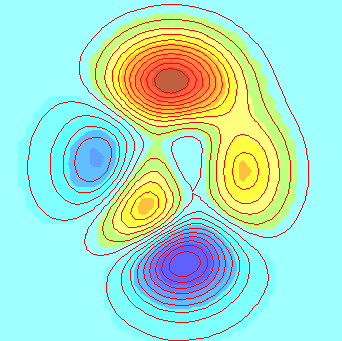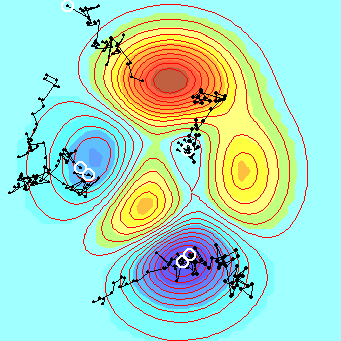CS4601: Introduction to Intelligent Computing
Random Search
 A Truly Random Search Method:
A Truly Random Search Method:
- Step 1:
- Choose a start point
 as the current point.
as the current point.
- Step 2:
- Add a random vector
 to the current point
to the current point
 in the parameter space and evaluate the objective
function at the new point at
in the parameter space and evaluate the objective
function at the new point at
 .
.
- Step 3:
- If
 ,
set the current point
,
set the current point
 equal to
equal to
 .
.
- Step 4:
- Stop if the maximum number of function evaluations is reached.
Otherwise, go back to step 2 to find a new point.
 Observations That Leads to Heuristics:
Observations That Leads to Heuristics:
- Observation 1:
- If search in a direction results in a higher objective
function, the opposite direction can often lead to a
lower objective function.
- Observation 2:
- Successive successful searches in a certain direction should
bias subsequent searching toward this direction. On the
other hand, successive failures in a certain direction should
discourage subsequent searching along this direction.
The first observation leads to a reverse step
in the original method.
The second observation motivates the use of a
bias term as the center for the random vector.
 A Random Search Method with Some Heuristics:
A Random Search Method with Some Heuristics:
- Step 1:
- Choose a start point
 as the current point. Set initial bias
as the current point. Set initial bias
 equal to a zero vector.
equal to a zero vector.
- Step 2:
- Add a bias term
 and a random vector
and a random vector
 to the current point
to the current point
 in the input space and evaluate the objective function
at the new point at
in the input space and evaluate the objective function
at the new point at
 .
.
- Step 3:
- If
 ,
set the current point
,
set the current point
 equal to
equal to
 and the bias
and the bias
 equal to
equal to
 ;
go to step 6. Otherwise, go to the next step.
;
go to step 6. Otherwise, go to the next step.
- Step 4:
- If
 ,
set the current point
,
set the current point
 equal to
equal to
 and the bias
and the bias
 equal to
equal to
 ;
go to step 6. Otherwise, go to the next step.
;
go to step 6. Otherwise, go to the next step.
- Step 5:
- Set the bias equal to
 and go to step 6.
and go to step 6.
- Step 6:
- Stop if the maximum number of function evaluations is reached.
Otherwise go back to step 2 to find a new point.

|
|
Flowchart for random search
|
 Random Search for Continuous Optimization: An Example:
Random Search for Continuous Optimization: An Example:
Find the min. of the peaks function:
z = peaks(x, y)
= 3*(1-x)^2*exp(-(x^2) - (y+1)^2)
- 10*(x/5 - x^3 - y^5)*exp(-x^2-y^2) - 1/3*exp(-(x+1)^2 - y^2).

|

|
|
Surface plot of z = peaks(x, y)
|
Contour plot of z = peaks(x, y)
|
Random search process:
(You can watch the animation of random search for the "peaks"
function by executing the MATLAB file
go_rand.m located at
ftp://ftp.cs.nthu.edu.tw/pub/CS/papers/jang/book/soft. Other
auxiliary files are:
peaksfcn.m.)

|
|
An example of random search
|
 Advantages of Random Search:
Advantages of Random Search:
- Derivative-free
(derivatives of the peaks function).
- Intuitive
- Easy to incorporate new heuristics
- stochastic and less likely to get trapped in local minima
 Weakness of Random Search:
Weakness of Random Search:
- Slow
- Heuristics given above are only good for continuous optimization.
 Reported Random Search Applications:
Reported Random Search Applications:
- Neural networks modeling
- Fuzzy modeling
- Some kines of discrete optimization
- All kinds of continuous optimization
 Reference:
Neuro-Fuzzy and Soft Computing
Reference:
Neuro-Fuzzy and Soft Computing
This page is maintained by
Jyh-Shing Roger Jang.
Comments and suggestions are welcome:
jang@cs.nthu.edu.tw.
 A Truly Random Search Method:
A Truly Random Search Method:
 A Truly Random Search Method:
A Truly Random Search Method:
 Observations That Leads to Heuristics:
Observations That Leads to Heuristics:
 A Random Search Method with Some Heuristics:
A Random Search Method with Some Heuristics:

 Random Search for Continuous Optimization: An Example:
Random Search for Continuous Optimization: An Example:



 Advantages of Random Search:
Advantages of Random Search:
 Weakness of Random Search:
Weakness of Random Search:
 Reported Random Search Applications:
Reported Random Search Applications:
 Reference:
Neuro-Fuzzy and Soft Computing
Reference:
Neuro-Fuzzy and Soft Computing